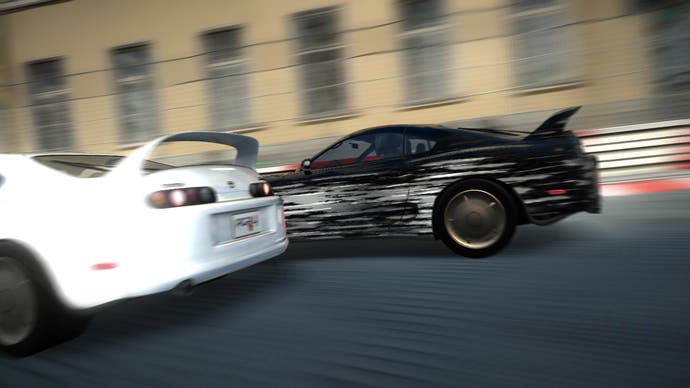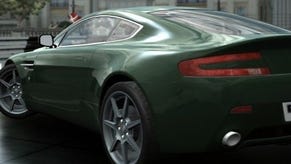Project Gotham Racing 4
Got ham?
And the bikes. You'll be able to read more about how bikes arrived in PGR in our full interview with Gareth Wilson very soon, but a chat with lead designer Ged Talbot ought to reassure PGR fans. So we had one. "We wanted to do them better than anyone had before," he says. But, of course, Gotham is not a simulation, and so MotoGP was hardly an appropriate model. Instead the inspiration was actually Grand Theft Auto. Apparently "it's the only bike game we played that everyone in the office loved...so credit to them".
You can of course fall off bikes, but the degree to which you topple changes when you're offline versus when you're on. Offline, the AI "remains neutral", so you won't be barged off too much, but if you overdo an endo or smash into a wall at 180mph you will take a tumble. Online, you're less prone to falling off simply because people online tend to try and ram one another anyway. "It's just what people do," says Talbot, without sounding too upset about it.
Talbot also points out that, despite the presence of a stunt button for people who want to dangle off their bike on straights for a few extra Kudos, Bizarre's deliberately avoided a complicated stunt system in order to preserve playability. They have also worked hard to balance bike Kudos and car Kudos. "We had to make a lap in a car and a lap in a bike achieve the same amount of Kudos," Talbot says, which is exactly what we needed to hear.
Bikes have also helped influence other areas of the design, like the choice of cities. Macau is in despite its relative proximity to Shanghai, and that's because of its real-world popularity with bikers - enthusiasm that Bizarre shares. Each city in PGR4 was photographed extensively (Macau was built off 24,000 snaps, accumulated during two art-team visits), and the maturation of Bizarre's art approach means they get a lot more detail from the 360 than before, which is why the old tracks (Nurburgring, for example) have also been rebuilt. And so, apart from a few very insignificant details (exact heights may be off here and there, for example, because they did all that by eye), what you're racing around are even more excellent facsimiles of the real world locations than ever.

Well, that and some of the road layouts, because one of the other ideas Bizarre has seized upon for PGR is this concept of "racification", which we alluded to last time.
Some testers responded that the handling was somehow simpler or more forgiving than PGR3, but Bizarre insists that that's not true. The difference is that things like turn-marker positioning, and the placement of rumble strips, give you a clearer idea of the optimal line without having to ram it down your throat [surely "eyes" - Ed].
Similarly, there are now three distinct bands of tyre noise for each car, giving you subtle audio cues when you're about to spin off. "A lot of it is designed to give the player feedback; to make them better at the game," audio manager Nick Wiswell tells us. If you have 5.1 sound, you can even hear which tyre is losing traction. Attention to detail, see. On that note, your no-nonsense bumper-cam view now boasts speed-o-meter and rev gauges modelled on the real thing. For every car and bike. "We probably shouldn't have done that," says Wilson, ruing the time it took. Oh well, at least they finished on time.
And yes, that does include all the online stuff. You can play split-screen or System Link offline, and online you have Xbox Live support (including guest support), using a "party" system similar to Halo's lobbies. You send invites, build up a group, and then move between different races and tasks as a group. You can even do Ranked events as a party.
Ranked is the TrueSkill side of the game, while Custom is "pretty much identical to PGR3". There are single-player events (basic online races), single-player championships (several online racers in championship format), and a range of team-based tasks - red vs. blue team races, hot laps and speed tests (cumulative mph for each team wins). There's also a "Simulation" set of events, where the in-car view and manual transmission are obligatory and the weather conditions are the most demanding. "We think people got frustrated [with PGR3] when they couldn't find people as good as they are."
On the flip side, things will also be less elitist. Daily tournaments will split players into groups of their own skill level to compete against one another, rather than trying to pick the best in the world all the time, and a "Hall of Fame" leaderboard will keep track of daily winners - as well as those who tot up the most day-to-day wins.
Equally personal is PGR On Demand, the evolution of PGR3's Gotham TV. It's a system that allows you to upload and download photographs and videos. Photos can be displayed in your garage (also home to Geometry Wars Waves, a wicked new version of the classic two-stick shooter where waves of enemies attack you from each side). Photos can also be viewed on the Internet through PGRNations.com, although videos cannot.

On the whole, then, PGR4 sounds a lot more rounded than PGR3, and there are lots of good ideas. The PGR Shop, to name one more, now clumps unlockables together in themed packs (Chevy Pack, Best of British etc). "We're hoping people will get the car they want, but also some other things they might not otherwise try," says Wilson. And everything is bought with Kudos, which is less confusing. You can even spend 1,000,000 Kudos - a ridiculous amount, relative to the rest of the stuff on offer - on a special gamer picture. That's a bit cheeky.
And now, with all that out of the way, what next for the PGR team? Downloadable content? "We're working on it right now, I don't mind telling you," says Wilson. "It'll be cars and bikes probably." And then, do they expect to make a PGR5? "Christ!" says Wilson. "I've not even finished PGR4 yet, Tom!"
Yes you have. And it's very good.
Project Gotham Racing 4 is due out exclusively on Xbox 360 on 12th October.


